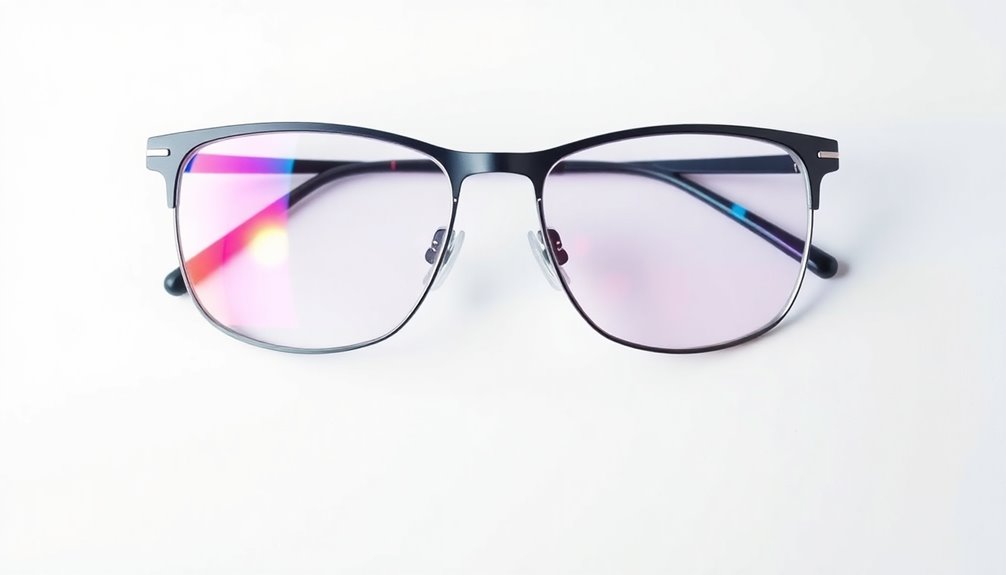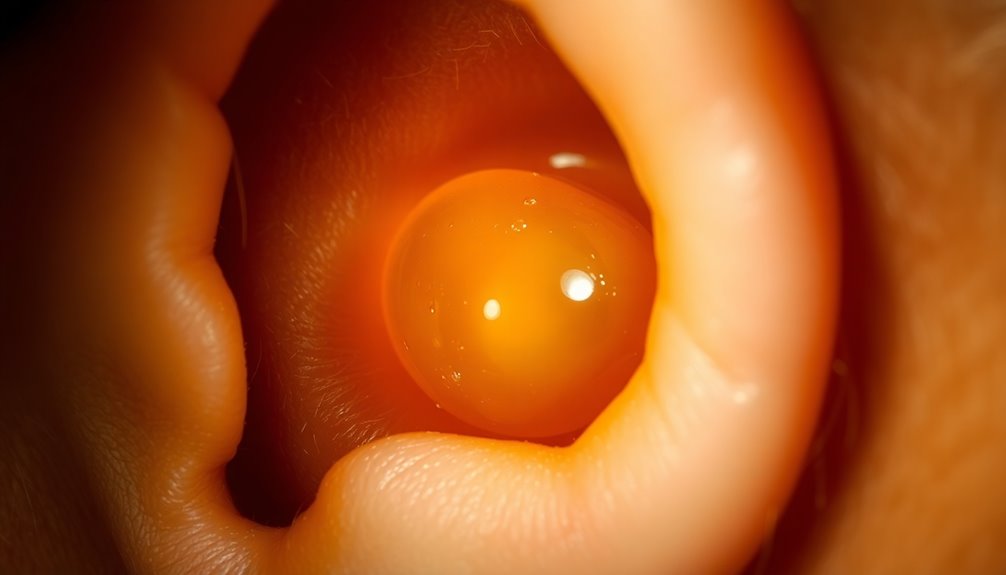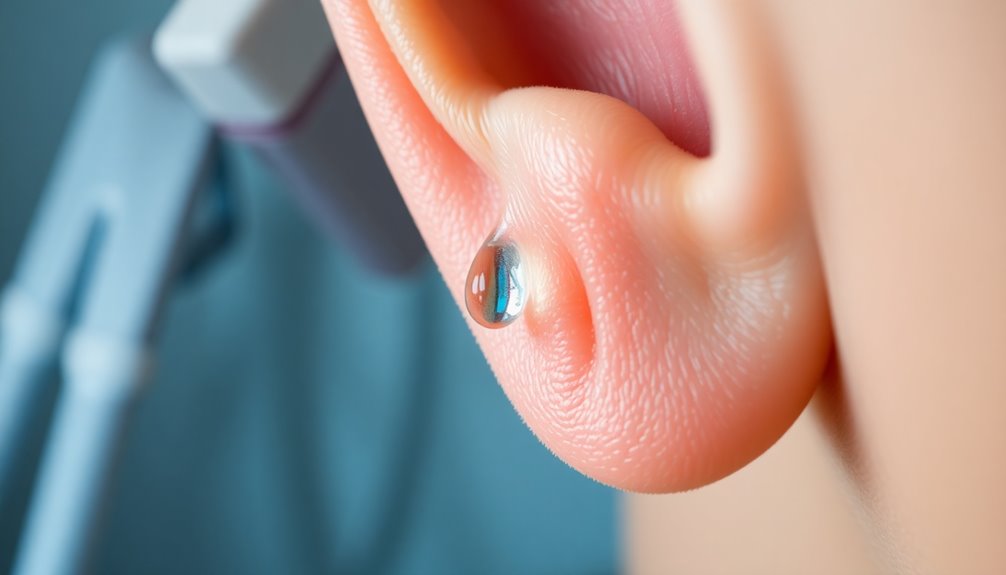Glasses with integrated hearing aids are changing how you perceive the world. These innovative combos use advanced technology like bone conduction and directional sound control, allowing you to enjoy enhanced audio without compromising your vision. Whether it's Bluetooth connectivity in smart audio glasses or customizable features through smartphone apps, these devices maximize comfort and functionality. You'll experience improved speech comprehension and greater awareness of your surroundings. Plus, their discreet designs help reduce the stigma around hearing aids. If you're curious about how this fusion can elevate your daily life, there's even more exciting information ahead.
Key Takeaways
- Combined glasses with built-in hearing aids utilize bone conduction technology for a seamless auditory experience while maintaining visual clarity.
- Smart audio glasses connect via Bluetooth, featuring microphones and speakers for enhanced sound and customizable hearing settings using a smartphone app.
- Advanced audio processing technology significantly improves speech comprehension by amplifying relevant sounds and reducing background noise.
- The discreet design of hearing aid glasses combats social stigma, offering a subtle solution for those with hearing impairments.
- Future advancements promise more affordable, accessible, and user-friendly solutions, reshaping the landscape of hearing aids and eyeglasses.
Types of Glasses With Hearing Aids
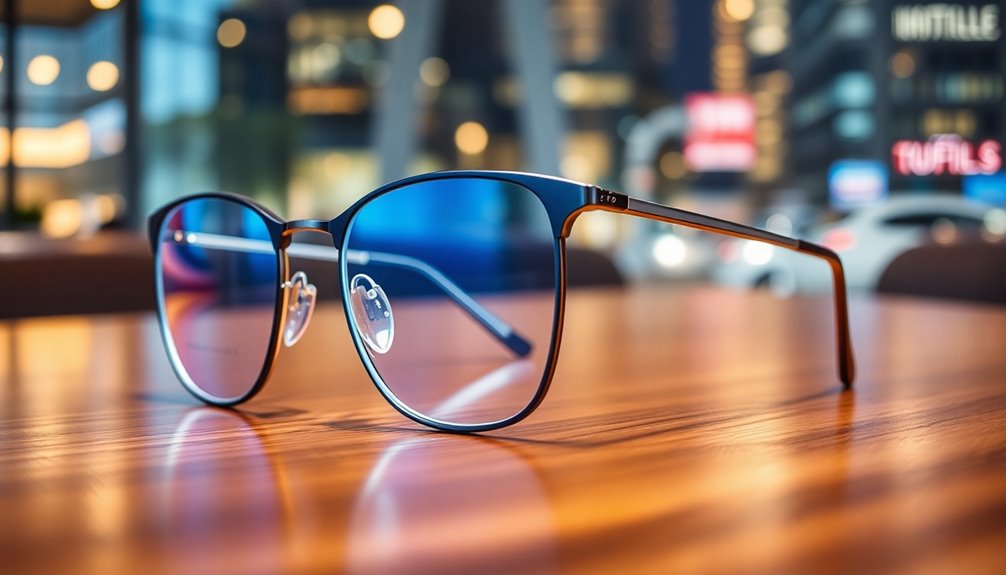
When it comes to glasses with hearing aids, you have several innovative options to choose from. One popular choice is combined glasses with hearing aids, which integrate hearing aids directly into the frame. These glasses often use bone conduction technology, discreetly placing the hearing aids within the arms, making them suitable for those with conductive or mixed hearing loss. It's important to note that comfort and functionality depend on selecting the right combination of hearing aids and glasses. Many users find that best hearing aids enhance their overall experience significantly.
Another option is behind-the-ear (BTE) compatible glasses. These hearing aids rest behind your ear, allowing you to wear glasses without interference, while the speaker sits inside your ear canal. You'll find lightweight models that ensure comfort throughout the day, which is crucial for individuals who wear them for extended periods.
Smart audio glasses are also gaining traction. They combine speakers and microphones, connecting via Bluetooth to enhance sound and assist with communication. These glasses can even display subtitles on the lens using speech-to-text technology, making them an exciting tool for those who enjoy movies and live performances.
Lastly, adaptable hearing aid glasses allow you to click a hearing aid onto your existing frames. This option can be customized for different types of glasses, though fitting might require some technical expertise. Each type presents unique advantages, so you can choose the one that best meets your vision and hearing needs.
Innovative Technology Features

Glasses with hearing aids come packed with innovative technology features that enhance both sound quality and user experience. You'll benefit from advanced audio processing capabilities, like beamforming technology that amplifies sounds directly in front of you while reducing ambient noise. Real-time noise reduction ensures conversations remain clear by filtering out distracting background sounds. The directional sound control adjusts audio based on where you're looking, providing an intuitive listening experience.
Embedded invisibly into the frames, the microphones, speakers, and algorithms work seamlessly together. You can customize your hearing settings through a smartphone app, offering you complete control. With open-ear speakers built into the frames, you won't need any uncomfortable ear tips. Accelerometers track your head movements, automatically adjusting hearing aid settings to fit your actions. The glasses also combine vision correction with hearing aid technology, providing a dual solution for users.
Smart and adaptive features predict your needs, adjusting sound processing based on your movements. An intuitive mode maximizes speech clarity in conversations, making interactions effortless. Plus, these glasses boast a sleek design that looks just like regular eyewear, so you can wear them confidently. With lightweight frames and a luxury aesthetic, they redefine what it means to combine style and functionality.
Benefits for Hearing Impairment
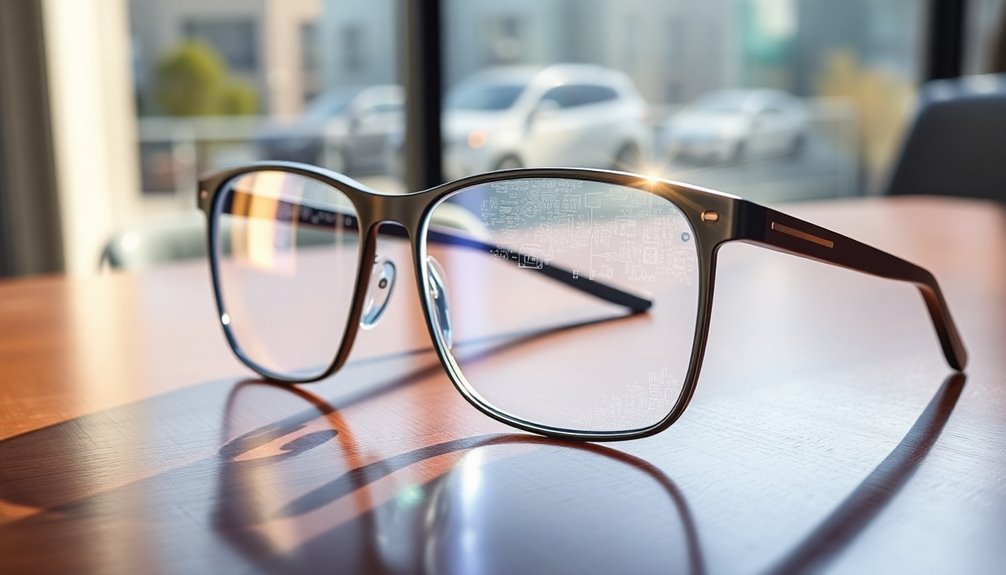
The integration of hearing aids into eyewear provides significant benefits for individuals with hearing impairments. You'll experience improved hearing and speech comprehension, especially if you have sensorineural hearing loss. While these devices won't restore normal hearing, they increase your awareness of sounds and help you understand speech more clearly, especially when worn in both ears. This can reduce feelings of social isolation and cognitive decline often associated with untreated hearing loss.
Wearing glasses with hearing aids is compatible, as behind-the-ear aids can fit comfortably with proper adjustments. Inside-the-canal aids typically won't conflict thanks to their small size. You can choose glasses frames that accommodate your hearing aids, benefiting from retention bands and anti-slip hooks to keep everything securely in place. Additionally, the classic hearing glasses integrate hearing systems into the arms, providing a discreet design that enhances user comfort.
This combination is particularly useful for those who require both visual and auditory support, ensuring you won't miss sounds while wearing glasses. Innovative designs are making hearing aids more socially acceptable, blending seamlessly with your eyewear. You'll find that this fusion not only enhances your hearing but also improves your overall quality of life, making daily interactions more enjoyable and less strenuous.
Market Demand and User Needs
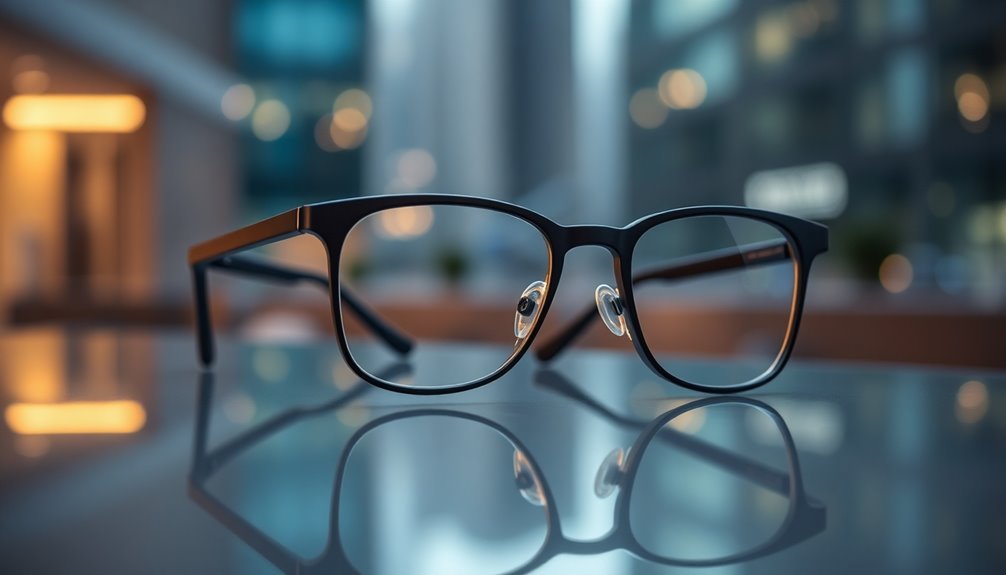
As demand for innovative solutions to hearing loss ramps up, integrating hearing aids into eyewear has emerged as a compelling option. With an estimated 2.5 billion people projected to experience hearing loss by 2050, the need for discreet and stylish solutions has never been greater. Traditional hearing aids often come with stigma, making the Nuance Audio smart glasses an attractive alternative. They blend seamlessly into regular eyewear, allowing you to enjoy the benefits of hearing assistance without the visibility of typical devices. Emotional dysregulation can affect how users perceive and adapt to new technologies, making it essential for product design to consider psychological factors. Additionally, having a clear advance directive in place can help users make informed decisions about their hearing health as they age. Investing in reliable products can also enhance overall satisfaction and long-term use, similar to the benefits seen with Gold IRA accounts that provide tax advantages. Furthermore, engaging in traditional healing practices may support holistic well-being, complementing the use of these advanced devices.
The market is also becoming increasingly accessible. Thanks to new FDA regulations permitting over-the-counter sales, you can now find these glasses in optical stores without needing a prescription. EssilorLuxottica's extensive distribution network makes it easier than ever to access these innovative products. Plus, customizable hearing settings through a smartphone app enhance user satisfaction, addressing specific preferences. EssilorLuxottica's acquisition of Nuance Audio has positioned them uniquely within the hearing technology market.
The competitive landscape is heating up, with brands like Jabra, Bose, and Sony entering this space. This competition is crucial for driving down prices and improving product offerings, ultimately ensuring that you have a variety of stylish, effective options to choose from.
Integration With Other Technologies

Integrating advanced audio technologies into eyewear transforms how you experience sound and communication. Imagine wearing glasses that feature built-in microphones and speakers, capturing and amplifying speech while reducing background noise. These glasses use beam-forming technology to isolate audio in front of you, directing sound straight toward your ear canal for enhanced clarity, even in noisy environments. Additionally, many of these glasses offer an open design that allows for ambient sound awareness, enhancing safety while using them outdoors. The need for advanced security measures in technology integration is vital to protect user data and enhance overall functionality.
With Bluetooth connectivity, these smart glasses connect seamlessly to your smartphone, allowing you to customize hearing settings through an app. You can stream music, podcasts, and other audio content directly to your glasses, making everyday experiences more enjoyable. Plus, you can adjust your hearing settings in real time, adapting to your environment effortlessly.
Directional sound control takes your listening experience to the next level by isolating sounds based on where you're looking, filtering out peripheral noise. Noise-cancellation microphones enhance speech clarity, ensuring you hear conversations without distractions. Some models even incorporate augmented reality features, converting speech to text and displaying subtitles, which enhances communication for users with hearing loss. This innovative integration not only improves auditory experiences but also opens the door to a future where audio and visual cues work together harmoniously.
User Experience and Satisfaction
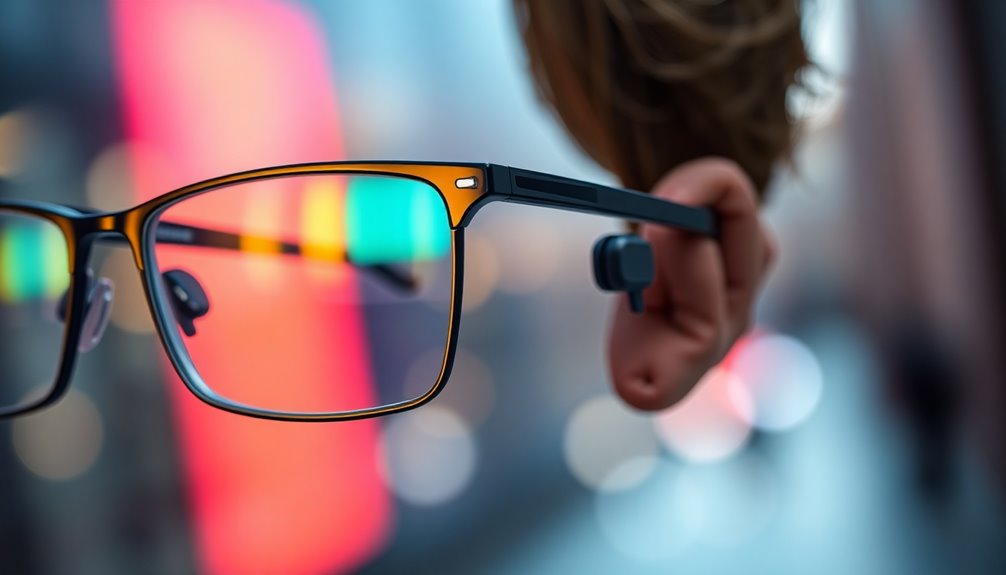
Many users find that combining glasses with hearing aids can enhance their overall experience, but comfort and adaptation play crucial roles in achieving satisfaction. If you're considering this combo, the fit of both devices is essential. Slimmer eyeglass frames can help reduce pressure and skin irritation, making your day-to-day wear more comfortable. Adjusting the receiver wire on behind-the-ear (BTE) hearing aids may also alleviate any discomfort.
You might need some time to adapt to wearing both together, so patience is key. Real-world testing, like in noisy restaurants, shows that the new EssilorLuxottica hearing aid glasses provide significant improvements in sound clarity. Users with hearing loss often report high satisfaction levels, especially with the advanced sound processing capabilities found in models like Jabra Enhance Select. Additionally, the integration of directional hearing technology in these glasses enhances the ability to understand conversations even in crowded environments.
While you may encounter minor issues like whistling or discomfort, these can typically be resolved by consulting an audiologist. Remember, finding the right eyeglass frames that accommodate your hearing aids is vital for both comfort and audio performance. By addressing these practical challenges, you can enhance your experience and enjoy the benefits of this innovative technology.
Impact on Healthcare Industry
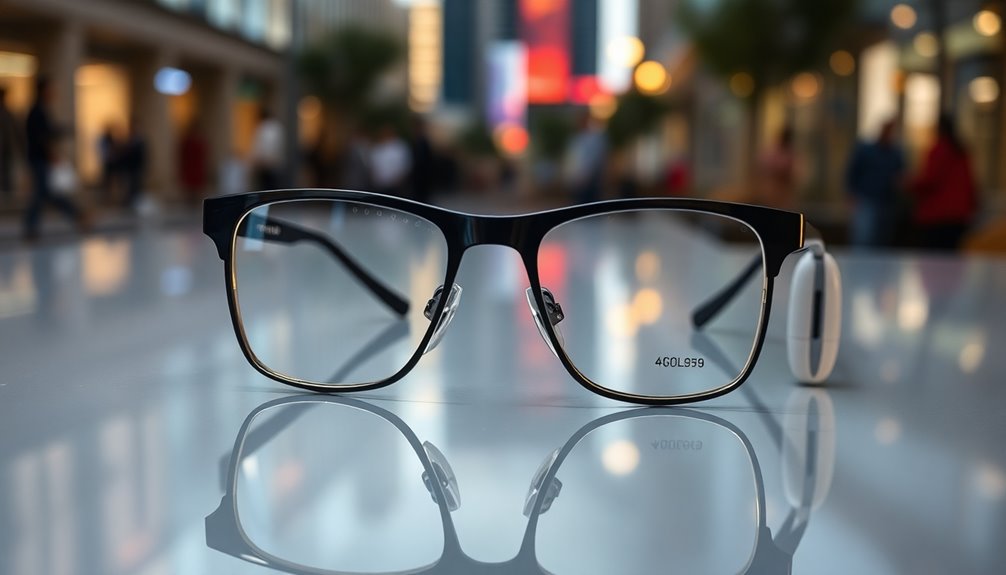
The emergence of glasses with integrated hearing aids is reshaping the healthcare industry, making hearing solutions more accessible and user-friendly. With major companies like EssilorLuxottica entering the hearing aid market, you're seeing a shift towards innovative products that combine vision and hearing support. This integration not only enhances functionality but also simplifies the user experience. Additionally, age-related hearing loss is a significant public health issue that these advancements aim to address.
Over-the-counter sales of hearing aids, thanks to new FDA guidelines, are creating opportunities for direct-to-consumer models. This accessibility means you can find solutions that fit your needs without the traditional barriers of prescription requirements. Major brands like Sony and Bose are also stepping up their game, driving competition and innovation in the market.
These advancements are changing how hearing healthcare is delivered. You can now control your hearing aids through smartphone apps, making it easier to tailor your experience. Plus, as companies focus on compliance with safety standards and transparent labeling, you'll have more confidence in your purchase decisions.
Ultimately, these developments promise to improve affordability and accessibility, ensuring that hearing solutions are within your reach and tailored to your lifestyle.
Reducing Stigma Around Hearing Aids
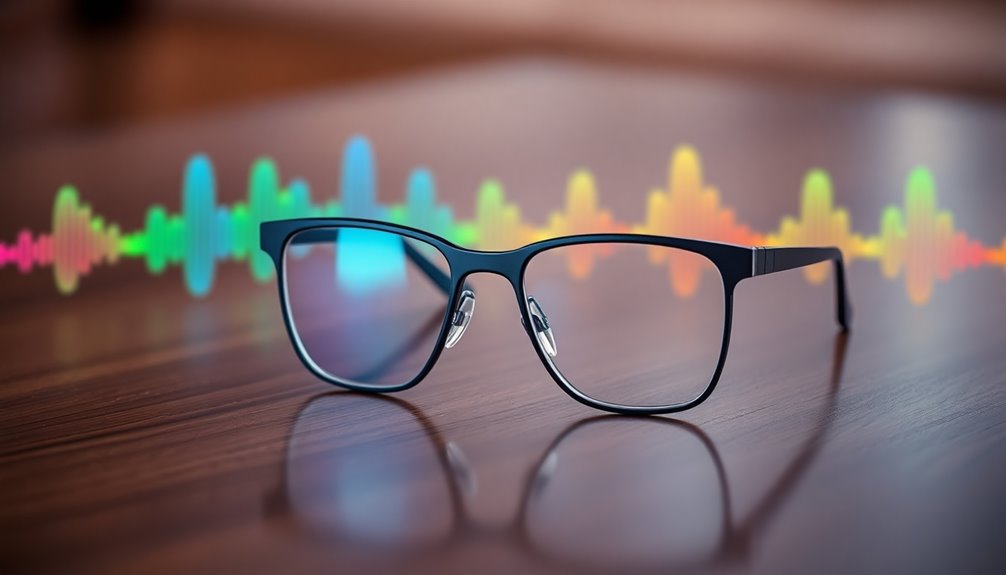
Reducing stigma around hearing aids is essential for fostering acceptance and encouraging individuals to seek the help they need. By increasing awareness and understanding of hearing loss, you can help dispel myths and challenge negative stereotypes. Public awareness campaigns and educational resources play a vital role in reshaping perceptions about hearing aids, normalizing their use, and highlighting technological advancements that make them more appealing. Additionally, understanding that negative societal attitudes contribute to stigma can help individuals and communities work together to create a more inclusive environment.
Assertive communication is key. When you openly discuss your hearing loss and the use of hearing aids, you challenge negative attitudes and inspire others to do the same. Positive self-talk can help you overcome internalized stigma and build self-confidence. Embracing diversity and recognizing that hearing differences are part of the human experience promotes broader acceptance.
Societal and cultural shifts are underway, similar to the evolution of eyeglasses from stigma to style. Celebrity advocacy can also reduce stigma, as public figures share their experiences with hearing loss. Support networks, whether through groups or online forums, provide validation and encouragement. By connecting with others, you empower yourself and prioritize your auditory health, contributing to the overall reduction of stigma surrounding hearing aids.
Frequently Asked Questions
Are These Glasses Suitable for Children With Hearing Loss?
Yes, these glasses can be suitable for children with hearing loss. They're designed to accommodate hearing aids comfortably, using flexible frames and adjustable components to ensure a proper fit. You can consult with an audiologist to find the best options for your child's specific needs. Additionally, features like bone conduction technology and sound amplification make them effective for various types of hearing loss, promoting both functionality and comfort for active kids.
How Do I Clean and Maintain These Glasses?
To clean and maintain your glasses, use a soft microfiber cloth daily to prevent scratches. Store them in a case or a safe spot when not in use. If they don't fit properly, visit an optician for adjustments. For frames, choose lightweight styles that work well with hearing aids, and consider using silicone grips to keep them secure. Regularly check both devices for comfort and functionality to avoid any issues.
Can I Customize the Prescription Lenses?
Yes, you can customize your prescription lenses! When selecting lenses, consider multifocal options for both near and distance vision. Consult with an optician to find the best fit for your needs. They'll guide you through the adaptation process and help you choose from various frame styles. Make sure to have a professional fitting to ensure everything works seamlessly together. Regular check-ups will also help you make necessary adjustments over time.
What Is the Average Battery Life of These Glasses?
The average battery life of these glasses ranges from 8 to 10 hours, depending on the noise level and how you use them. If you're in a moderately noisy environment, you can expect them to last through your entire day. Just keep in mind that high noise levels may drain the battery faster. They're designed for daily use, so you won't have to worry about frequent recharging.
Are There Any Insurance Plans That Cover These Devices?
Yes, some insurance plans do cover hearing aids, but coverage varies. You'll find that major providers like Aetna and Blue Cross Blue Shield offer different benefits depending on your plan and state. Some plans might even cover routine exams. However, you should check for specifics, such as whether you need to purchase from approved providers or if there are limits on replacements. Always review your plan details to know what's included.
Conclusion
In conclusion, glasses with hearing aids represent a groundbreaking advancement that enhances your daily life. By combining vision and sound in one sleek device, you'll not only enjoy improved functionality but also embrace a stylish solution that reduces the stigma around hearing aids. With increasing market demand and innovative features, this futuristic combo is set to revolutionize how you experience the world. It's time to embrace this remarkable technology and enjoy a more connected, enjoyable lifestyle!
